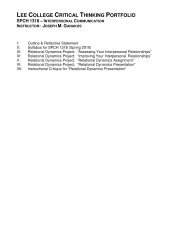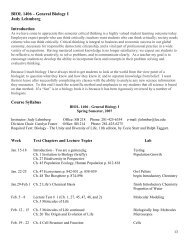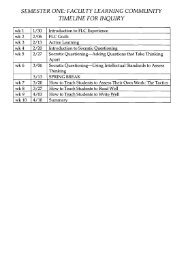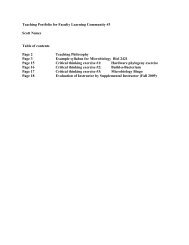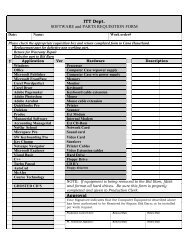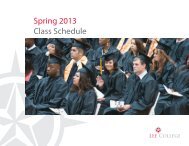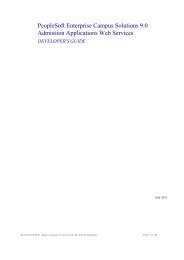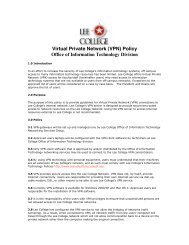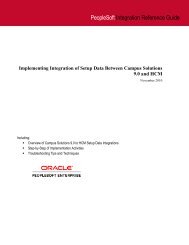The Community and Lee College
The Community and Lee College
The Community and Lee College
Create successful ePaper yourself
Turn your PDF publications into a flip-book with our unique Google optimized e-Paper software.
About <strong>Lee</strong> <strong>College</strong><br />
<strong>Lee</strong> <strong>College</strong> was established in 1934, <strong>and</strong> when registration was completed<br />
for that first semester, 177 students had enrolled in the inaugural session<br />
of <strong>Lee</strong> Junior <strong>College</strong> of Goose Creek, Texas. <strong>The</strong> Board of Trustees of the<br />
Goose Creek Independent School District had agreed as early as 1931<br />
that a junior college should be established to provide educational<br />
opportunity to students who could not otherwise afford it.<br />
<strong>The</strong> first graduation was on May 24, 1935, with four women receiving<br />
diplomas: Juanita Barrington (Mrs. David Holm), Byrtis Avey (Mrs. Elmer<br />
Brinkley), La Del Payne (Mrs. Barney Hillard) <strong>and</strong> Hudnall Spence (Mrs.<br />
Robert Southwick). A 33 percent increase in the fall of 1935 boosted<br />
enrollment to 236.<br />
<strong>The</strong> founders of the college were interested in providing a strong academic<br />
curriculum <strong>and</strong> a comprehensive technical/vocational curriculum. In<br />
1936, the vocational program was initiated. Later, it became known as<br />
the Robert E. <strong>Lee</strong> Institute, Vocational Division of <strong>Lee</strong> Junior <strong>College</strong>. No<br />
college credit was given for work in the institute until 1941, <strong>and</strong> it did not<br />
become an integral part of the college until 1945, following a two-year<br />
period when no technical/vocational courses were offered.<br />
By the mid-1940s, the administration <strong>and</strong> faculty of the college had<br />
become increasingly aware that the college needed its own governing<br />
board. In 1945, Walter Rundell, one of the original faculty members,<br />
became Dean of <strong>Lee</strong> <strong>College</strong>. Dean Rundell became the guiding force<br />
behind major developments for the two decades which followed. In<br />
1948, the name was changed to <strong>Lee</strong> <strong>College</strong>. In the same year, <strong>Lee</strong><br />
<strong>College</strong> gained accreditation from the Southern Association of <strong>College</strong>s<br />
<strong>and</strong> Schools. <strong>The</strong> association urged <strong>Lee</strong> <strong>College</strong> to develop a campus<br />
facility separate from the high school.<br />
A successful bond election in 1949 led to the completion of the first two<br />
buildings, the administration building <strong>and</strong> the gymnasium. <strong>The</strong> college<br />
moved to the new campus in 1951. Following the move to a separate<br />
campus, the growth of the college exceeded the expectations of the<br />
leaders, <strong>and</strong> plans for additional buildings had to be accelerated. A<br />
Liberal Arts Building, now Social Sciences, was added in 1958. By 1961,<br />
the campus had doubled in size. <strong>The</strong> library was completed <strong>and</strong> the<br />
gymnasium exp<strong>and</strong>ed in 1962. Moler Hall, Technical Vocational Building<br />
One, <strong>and</strong> Bonner Hall followed.<br />
Under the leadership of Dean Rundell, <strong>Lee</strong> <strong>College</strong> successfully separated<br />
from the local public school district in 1965. On August 18, 1965, <strong>Lee</strong><br />
<strong>College</strong>’s first Board of Regents, appointed by the public school board,<br />
assumed governance of the college.<br />
A significant event in the history of <strong>Lee</strong> <strong>College</strong> occurred in 1966, when<br />
the college, under the leadership of Dean Rundell <strong>and</strong> George Beto, in<br />
cooperation with the Texas Department of Corrections, began a program<br />
of courses in the state’s prison system. This program has grown from 182<br />
students that first year to a current enrollment which exceeds 1000 students.<br />
In 1966, Dr. Richard Strahan became the first full-time president of <strong>Lee</strong><br />
<strong>College</strong>. Since the separation from the local public school district, the<br />
college has had seven presidents: Dr. Strahan, 1966-71; Dr. Raymond<br />
Clevel<strong>and</strong>, 1971-73; Dr. Jim Sturgeon, 1973-76; Dr. Robert Cloud, 1976-<br />
86; Dr. Vivian B. Blevins, 1986-1991; Dr. Jackson N. Sasser, 1992-2001,<br />
<strong>and</strong> Dr. Martha M. Ellis, current president.<br />
In 1969, <strong>Lee</strong> <strong>College</strong>, in cooperation with two Liberty County school<br />
districts, began offering courses at Liberty <strong>and</strong> Dayton. Another milestone<br />
in the history of <strong>Lee</strong> <strong>College</strong> was the offering of continuing education<br />
courses in 1972. <strong>The</strong>se community-oriented, short-term courses have<br />
experienced a dramatic growth in popularity <strong>and</strong> are further evidence<br />
of the flexibility of the community college concept. <strong>The</strong> <strong>College</strong> also<br />
established a program for senior adults in 1972.<br />
In 1986, <strong>Lee</strong> <strong>College</strong> began two new programs to serve not only <strong>Lee</strong><br />
<strong>College</strong>’s district constituents, but also interested citizens outside the<br />
college’s service area. <strong>The</strong> San Jacinto Mall site was the result of<br />
cooperation between the mall <strong>and</strong> the <strong>College</strong>.<br />
Coordination with local groups led to the formation of the Hispanic<br />
Educational Access Committee <strong>and</strong> the Black Educational Access<br />
Committee in the fall of 1986. <strong>The</strong> work of these committees has received<br />
favorable national recognition <strong>and</strong> has served to encourage educational<br />
access to these underrepresented groups.<br />
<strong>The</strong> <strong>Lee</strong> <strong>College</strong> Foundation, established in 1968 to provide scholarships<br />
to deserving <strong>Lee</strong> <strong>College</strong> students, today has assets of more than $3.5<br />
million <strong>and</strong> provides more than 275 scholarships each year.<br />
In order to provide funds <strong>and</strong> volunteers to support educational programs,<br />
the Friends of <strong>Lee</strong> <strong>College</strong> was founded in late fall of 1986. This group<br />
of community volunteers, under the leadership of John B. Tucker, has<br />
raised more than $2 million to support <strong>College</strong> programs <strong>and</strong> has had a<br />
major impact on facilities <strong>and</strong> programs.<br />
A focus on economic development resulted in the Small Business<br />
Development Center being opened in 1987. In response to needs of<br />
local industries, <strong>Lee</strong> <strong>College</strong> began to institute new industrial programs<br />
<strong>and</strong> to revise existing ones.<br />
Obtaining a Bachelor of Science degree in nursing became possible<br />
through an agreement with the University of Texas School of Nursing at<br />
Galveston in 1987 for registered nurses in the area.<br />
A successful bond election in 1988 enabled the college to initiate a construction<br />
program which featured a new science building, a lecture hall,<br />
<strong>and</strong> major renovations to several campus facilities.<br />
<strong>The</strong> 711 West Texas property, acquired in 1990, was renovated to house<br />
a performing <strong>and</strong> fine arts complex in addition to an allied health suite<br />
named the McNulty-Haddick Complex in honor of Alma Haddick <strong>and</strong> her<br />
husb<strong>and</strong> Luther.<br />
In February 2000, local voters passed a $20 million bond election to<br />
build a new advanced technology center/library, a completely renovated<br />
gymnasium <strong>and</strong> newly constructed sports/wellness complex. Other<br />
renovations <strong>and</strong> additional parking were also included.<br />
Today over 9,000 <strong>Lee</strong> <strong>College</strong> students are enrolled in academic, technical<br />
education, <strong>and</strong> non-credit continuing education programs each semester.<br />
Basic education is available for those seeking to improve skills in reading,<br />
writing, mathematics, <strong>and</strong> language in addition to a regionally acclaimed<br />
honors curriculum.<br />
<strong>Lee</strong> <strong>College</strong> Setting <strong>and</strong> Facilities<br />
<strong>Lee</strong> <strong>College</strong> is a public community college, located in Baytown, approximately<br />
thirty miles east of Houston.<br />
<strong>The</strong> <strong>College</strong> is situated on an attractive 40 acre campus. <strong>The</strong> buildings<br />
are complemented by lighted tennis courts, a Sports Complex including<br />
an arena <strong>and</strong> a multigenerational wellness center, with racquet ball courts<br />
<strong>and</strong> a heated swimming pool, <strong>and</strong> a newly completed Advanced<br />
Technology Center <strong>and</strong> Library. Moler Hall, at the campus center, also<br />
houses the admissions office, counseling center, college bookstore, <strong>and</strong><br />
snack bar. A 25,000 square foot newly renovated Student Center provides<br />
meeting space for student organizations, recreational <strong>and</strong> study areas as<br />
well as a cyber cafe with gourmet coffee <strong>and</strong> Internet access.<br />
144



